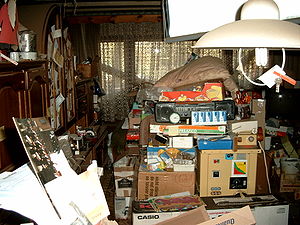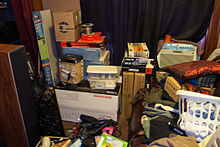15 Hoarding Disorder
Hoarding Disorder

Compulsive hoarding in an apartment
Compulsive hoarding, also known as hoarding disorder, is a behavioral pattern characterized by excessive acquisition of and an inability or unwillingness to discard large quantities of objects that cover the living areas of the home and cause significant distress or impairment. Compulsive hoarding behavior has been associated with health risks, impaired functioning, workplace impairment, economic burden, and adverse effects on friends and family members. When clinically significant enough to impair functioning, hoarding can prevent typical uses of space, enough so that it can limit activities such as cooking, cleaning, moving through the house, and sleeping. It can also put the individual and others at risk of fires, falling, poor sanitation, and other health concerns. Researchers have recognized compulsive hoarding as a phenomenon since at least the 1980s, but only recently have begun to study hoarding, and it was first defined as a mental disorder in the 5th edition of the DSM in 2013. It was not clear whether compulsive hoarding is a separate, isolated disorder, or rather a symptom of another condition, such as OCD, but the current DSM lists hoarding disorder as both a mental disability and a possible symptom for OCD. Prevalence rates have been estimated at 2% to 5% in adults, though the condition typically manifests in childhood with symptoms worsening in advanced age, at which point collected items have grown excessive and family members who would otherwise help to maintain and control the levels of clutter have either died or moved away. Hoarding appears to be more common in people with psychological disorders such as depression, anxiety and attention deficit hyperactivity disorder (ADHD). Other factors often associated with hoarding include alcohol dependence and paranoid, schizotypal and avoidance traits.
Signs and symptoms

Example of useful but unopened items
Compulsive hoarding in its worst forms can cause fires, unsanitary conditions such as rat and cockroach infestations and other health and safety hazards.
Listed below are possible symptoms hoarders may experience:
Holding onto a large number of items that most people would consider useless or worthless, such as:
Advertising mail, old catalogs, magazines, and newspapers; worn out cooking equipment; things that might be useful for making crafts; clothes that might be worn one day; broken things or trash; “freebies” or other promotional products.
Having a cluttered home to the point where many parts are inaccessible and can no longer be used for intended purposes. For example: beds that cannot be slept in, kitchens that cannot be used for food preparation, or tubs, showers, and sinks filled with items and can no longer be used for washing or bathing
Finally, the individual’s clutter is at a point where it is causing illness, distress, and/or impairment. For example, individuals may not allow visitors in, such as family and friends, or repair and maintenance professionals, because the clutter embarrasses them; they may get into a lot of arguments with family members regarding the clutter; they may be at risk of fire, falling, infestation, or eviction; and they may often feel depressed or anxious due to the clutter.
Diagnosis
The DSM-5 diagnostic criteria for hoarding disorder are:
Persistent difficulty discarding or parting with possessions, regardless of the value others may attribute to these possessions.
This difficulty is due to strong urges to save items and/or distress associated with discarding.
The symptoms result in the accumulation of a large number of possessions that fill up and clutter active living areas of the home or workplace to the extent that their intended use is no longer possible. If all living areas become decluttered, it is only because of the interventions of third parties (e.g., family members, cleaners, authorities).
The symptoms cause clinically significant distress or impairment in social, occupational, or other important areas of functioning (including maintaining a safe environment for self and others).
The hoarding symptoms are not due to a general medical condition (e.g., brain injury, cerebrovascular disease) or another mental disorders.
Many individuals with hoarding disorder do not recognize their hoarding as a problem. In one study, 42% of individuals with hoarding disorder found their behavior problematic compared to the 63% of their family and friends who saw the behavior as problematic. Low insight leads to poor treatment outcomes. In patients where compulsive hoarding is secondary to or comorbid with frank OCD, serotonergic antidepressants such as SSRIs or the tricyclic antidepressant clomipramine are indicated, although the presence of hoarding predicts relatively poor treatment response. When examined, concurrent pharmacological and psychotherapeutic treatment appeared more effective than either alone.
Cognitive-behavioral therapy (CBT) is a commonly implemented therapeutic intervention for compulsive hoarding. As part of cognitive behavior therapy, the therapist may help the patient to:
Discover why he or she is compelled to hoard.
Learn to organize possessions in order to decide what to discard.
Develop decision-making skills.
Declutter the home during in-home visits by a therapist or professional organizer.
Gain and perform relaxation skills.
Attend family and/or group therapy.
Be open to trying psychiatric hospitalization if the hoarding is serious.
Have periodic visits and consultations to keep a healthy lifestyle.
This modality of treatment usually involves exposure and response prevention to situations that cause anxiety and cognitive restructuring of beliefs related to hoarding. Furthermore, research has also shown that certain CBT protocols have been more effective in treatment than others. CBT programs that specifically address the motivation of the sufferer, organization, acquiring new clutter, and removing current clutter from the home have shown promising results. This type of treatment typically involves in-home work with a therapist combined with between-session homework, the completion of which is associated with better treatment outcomes. Research on internet-based CBT treatments for the disorder (where participants have access to educational resources, cognitive strategies, and chat groups) has also shown promising results both in terms of short- and long-term recovery.
Key Takeaways
Hoarding Disorder
A disorder characterized by excessive acquisition of, and an inability or unwillingness to discard, large quantities of objects that cover the living areas of the home and cause significant distress or impairment.
“Hoarding Disorder” is adapted from Abnormal Psychology by Coursehero, used under CC BY-SA: Attribution-ShareAlike.

